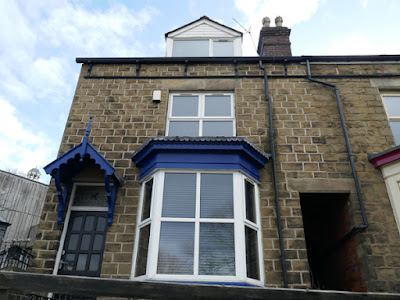 |
| Edwardian terraced houses on Ecclesall Road |
Following on from visits to Moorgate Cemetery and Boston Park in Rotherham - to prepare for the “Let’s talk about the stones” walk in April - March 2023 started with a trip to Ecclesall in Sheffield, to meet up with Paul and Dave of the Sheffield U3A Geology Group to finalise the field trip itinerary for the rest of 2023.
Since first undertaking a survey of Green Moor in Barnsley back in 1996, to identify potential RIGS (Regionally Important Geological Sites) in South Yorkshire, I have encountered the Greenmoor Rock in many places. Although I have been to Banner Cross, Greystones, Nether Edge and Endcliffe Park a few times, I couldn’t recall seeing any buildings in the area that I thought were obviously built with this sandstone - known in Sheffield as Brincliffe Edge Rock.
When coming down Ecclesall Road on the bus after a previous meeting at Paul’s house, I was struck by the obvious grey/green colour of the sandstone that has been used for the frontages of the brick built terraced houses, which were erected on its east side in various stages during the very late Victorian to Edwardian periods.
With a bit of time on hands before my meeting, I got off the bus from Sheffield at the Ecclesall Road/Rustlings Road stop to have a quick look at the terraced houses - Nos. 721-737 - on the east side of the Trinity United Reformed Church, which were built on a site that the 1905 Ordnance Survey map shows as a quarry and first appear on the 1924 edition, which was based on a resurvey of 1914/1915.
In 2021, I had spent a good part of the year travelling all over Sheffield to visit the Sheffield Board Schools, combining these with the British Listed Buildings Photo Challenge, during which I had traversed the major sandstone formations in Sheffield that have been used for building stone.
Although very few quarries are now visible, the physical characteristics of the principal sandstone formations that outcrop on the west side of Sheffield - the Chatsworth Grit, Crawshaw Sandstone and Loxley Edge Rock – are very different to the Greenmoor Rock, which is thinly bedded, fine grained and particularly suited to paving, headstones, lintels, sills and steps.
Nos. 739-749, on the west side of Trinity church, were built at a slightly earlier date and first appear on the 1905 map, which was revised from 1901 to 1903. Although more modest in style than the later Edwardian terraced houses, which have two storey bay windows and a gable attic floor, they are built out of a similar green/grey sandstone that has a dull light muddy brown patina.
I quickly walked up Ecclesall Road until I reached the Co-Op supermarket, which is built on the site of the former John Gregory brickworks, which opened c.1877 and closed c.1942, but I didn’t have time to look closely at the extensive rock face that can be seen here.
Stopping quickly to photograph the fine relief sculptures by Richard Watts at the Church of St. William of York, which I shall describe later, I took a couple of photos of the quarry face seen from a gennel to one of the terraced houses, which first appear on the 1905 Ordnance Survey map.









No comments:
Post a Comment